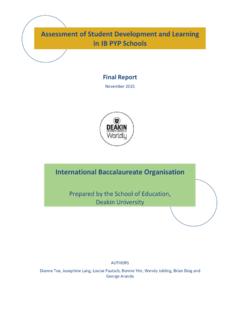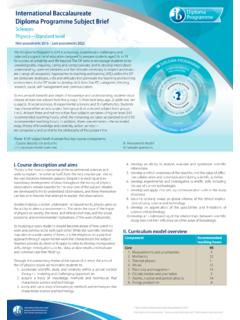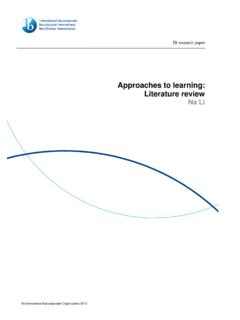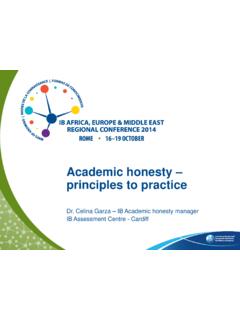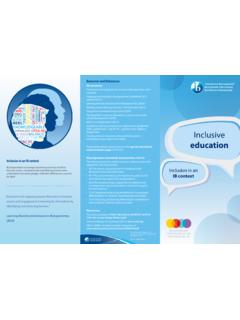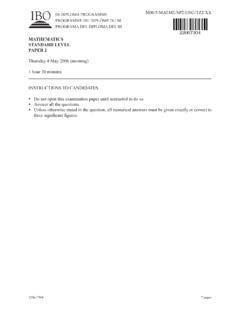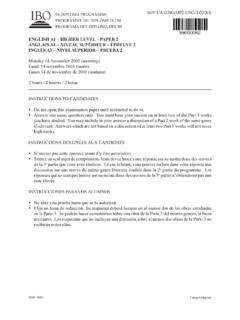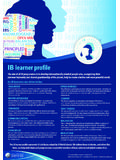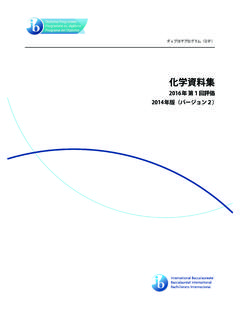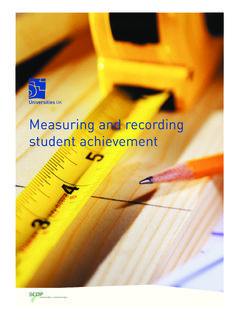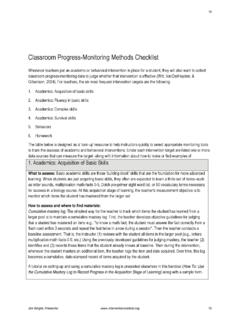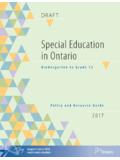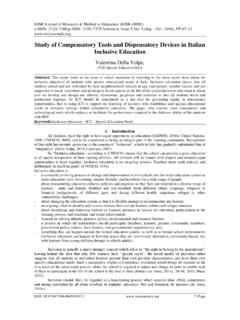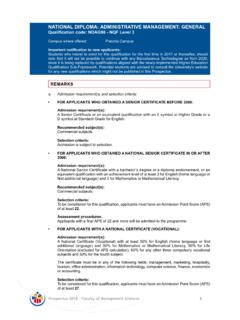Transcription of Language Proficiency for Academic Achievement in the ...
1 Language Proficiency for Academic Achievement in the international baccalaureate diploma Program Keira Ballantyne, . Charlene Rivera, The George Washington University Center for Equity and Excellence in Education July 2014 The George Washington University Center for Equity and Excellence in Education s mission is to advance education reform so all students achieve to high standards. GW-CEEE conducts policy and applied research, designs and implements programme evaluations, and provides professional development and technical assistance for clients in state education agencies, school districts, schools, foundations, and federal agencies. GW-CEEE The George Washington University Center for Equity & Excellence in Education The George Washington University Center for Equity and Excellence in Education l i Acknowledgements This report would not have been possible without the generous funding of the international baccalaureate Organization.
2 Heike Schr der of the Hague office of the international baccalaureate was instrumental in the organization and production of this work and provided valuable feedback and direction. We particularly thank her for her extensive work on refining the survey questions and methodology. At GW-CEEE, our colleagues Tracy Tressler and Jennifer McCreadie provided fruitful discussion and cross-pollination from their parallel study on international baccalaureate students. Jessica Saven contributed inferential statistical analyses of the survey and IBIS data. Finally, we would like to thank the survey participants who devoted their time and energy into providing us with detailed information on their schools and programs . Their input was instrumental to furthering our understanding of second Language students within the international baccalaureate diploma Programme. The George Washington University Center for Equity and Excellence in Education l ii Contents 1 Part I: Literature Review.
3 2 Part II: Review of Data .. 4 Part III: Survey of Academic Language Practices .. 7 Part IV: Academic Language Practices and Student Performance .. 9 Recommendations for Further Research and for Practice .. 11 I: Literature Review .. 14 Introduction .. 15 Defining Academic Language .. 15 Academic Language and Language Proficiency Levels .. 18 Academic Language Pedagogy .. 26 Affect and Efficacy .. 34 Conclusion .. 37 II: Review of Data .. 39 Summary of 40 1. Methodology .. 42 2. Demographics .. 43 3. Academic Performance .. 53 4. Conclusion .. 58 III: Survey of Academic Language Practices .. 59 Introduction .. 61 Methodology .. 62 Results .. 66 99 The George Washington University Center for Equity and Excellence in Education l iii IV: Academic Language Practices and the Performance of Second Language Students in IBDP Schools .. 105 Introduction .. 105 Research Questions .. 106 Methodology .. 107 Results .. 109 120 Conclusion.
4 123 References .. 125 Appendix A: Mother Tongue Demographics .. 129 Appendix B: Second Language Candidates by Country .. 133 Appendix C: Academic Performance, by Examination Session, 2008-12 .. 137 Academic Performance: November 2012 .. 137 Academic Performance: May 2012 .. 139 Academic Performance: November 2011 .. 141 Academic Performance: May 2011 .. 143 Academic Performance: November 2010 .. 145 Academic Performance: May 2010 .. 147 Academic Performance: November 2009 .. 149 Academic Performance: May 2009 .. 151 Academic Performance: November 2008 .. 153 Academic Performance: May 2008 .. 155 Appendix D: Survey Instrument .. 157 The George Washington University Center for Equity and Excellence in Education l iv Overview Overview The international baccalaureate diploma Programme (IBDP), designed for students aged 16 to 19, is an educational programme with final examinations intended to prepare students for success at university and life beyond.
5 ( international baccalaureate , 2013). The programme is implemented in 140 countries worldwide, in more than 3,000 schools ( international baccalaureate , 2014). IBDP candidates are linguistically and culturally diverse, with more than 200 mother tongues, five languages of instruction, three major languages of examination, and socially, culturally, and linguistically diverse geographical settings. This study, Language Proficiency for Academic Achievement in the international baccalaureate diploma Program, seeks to understand the factors which result in Academic success for those IBDP candidates who are in school settings where examinations and instruction are not in the student s mother tongue. The population of second Language learner students in the IBDP has grown by approximately half (51%) over the five years considered by this study (2008-2012), from more than 14,000 students in the 2008 examination periods to more than 21,000 second Language students in 2012. There were 21,399 second Language students in the 2012 examination sessions, constituting 16% of all IBDP candidates worldwide.
6 The following working definitions of languages for various purposes are used in the study. Mother tongue can be conceived of as the student s first Language or home Language . The concept of mother tongue can be difficult to operationalize, particularly for students with multilingual home backgrounds. For the current report, mother tongue designations are drawn from IB student records, with a recognition that the process of recording student mother tongue data is opaque and may not be consistent across IB schools. Language (s) of instruction is the Language or languages in which classroom instruction is delivered. The IBDP operates in three working languages--English, French, and Spanish and offers these three, as well as German or Chinese, as languages of instruction in its programs ( international baccalaureate , 2011). Response Language or examination Language is the Language in which students take IB examinations. English, French, and Spanish are designated response languages for IB examinations in the diploma Programme, with select examinations also offered in Chinese and German ( international baccalaureate , 2011).
7 Second Language learners, then, are defined for the present purposes as students whose mother tongue does not match either the Language of instruction or the response Language . Lingua franca is the dominant Language of the community, or the national Language . Note that it is not necessarily the most widely spoken, but rather the national Language of institutions such as government and education. The study is divided into four major sections. The first part of the study, the Literature Review examines the relevant Academic literature on research based and promising practices which support second Language students in acquiring Academic Language . The second part, Review of Data analyzes five years of demographic and performance data on the population of second Language students in the IBDP. The third part of the study, Survey of Academic Language Practices, surveys a set of 300 IBDP schools worldwide to investigate the kinds of practices in place. The fourth section, Academic Language Practices and the Performance of Second Language Students in IBDP Schools, analyzes survey responses with respect to student performance data.
8 The current document presents an overview of major insights and findings from the study as a whole. The George Washington University Center for Equity and Excellence in Education l 1 Overview Part I: Literature Review Defining Academic Language There is a general consensus in the literature that there exists a specific style of speaking and writing which is appropriate for the school context of Academic learning and Academic Achievement . Although researchers and theorists disagree on the exact nature of this Language style, it is widely accepted that students who are learning in a second Language require support in acquiring the Academic Language of the classroom (Anstrom et al. 2010; Bailey, 2007; Bailey, Butler, Stevens & Lord, 2007; Cummins, 1980; Dicerbo, Anstrom, Baker & Rivera, 2013; MacSwan & Rolstad, 2003; Schleppegrell, 2004). Academic Language , furthermore, is not a unitary concept. Researchers have identified both general and subject-specific aspects of the style (Anstrom, 2010; Bailey, 2007; Bailey, Butler, Stevens & Lord, 2007; Dicerbo, Anstrom, Baker & Rivera, 2013; Schleppegrell, 2004).
9 General Academic Language encompasses the Language conventions which typically apply across subject matter, and include, for instance, the introduction-body-conclusion pattern to writing an Academic essay, or the formal transitional vocabulary used in Academic text to move from one idea to the next (vocabulary such as furthermore or nevertheless). Subject-specific Academic Language includes not only the specialized vocabulary of the content areas, but also the subtle patterns of grammatical and discourse variance found between, for instance, an essay in economics and a report on a chemistry experiment. Levels of Language Proficiency A current open question is the level of Language and Academic Language Proficiency required for success in the IBDP. While the international baccalaureate collects useful and informative data on its student population in order to inform instruction, IB does not systematically collect information on student Language Proficiency . In part, this is because of the challenge of measuring student Language Proficiency in a comparable fashion across multiple assessments and frameworks which describe linguistic competence in distinct ways.
10 The review of literature considers three distinct frameworks for describing levels of Language Proficiency : the American Council on the Teaching of Foreign Languages (ACTFL) Proficiency Guidelines; the international Second Language Proficiency Ratings (ISLPR); and the Common European Framework for Language (CEFRL). This review of frameworks was conducted for the purpose of informing the survey of schools, which in turn investigated whether or not IB world schools tended to use diverse frameworks, or alternately, whether there is a common framework which is widely used. Should the latter be the case, this would inform IB s approach to materials and supports for schools with second Language students. The results of the survey (see below), however, indicate a diversity of frameworks and assessments to measure Language Proficiency across IB world schools. Academic Language Pedagogy: Professional Development and Instruction In order to provide effective instruction in the Academic Language needed for success in the content areas, teachers must be prepared to integrate Academic Language teaching into the teaching of the disciplines (Bunch, 2013; Heritage, Silva & Pierce, 2007; Wong-Fillmore and Snow, 2000).
